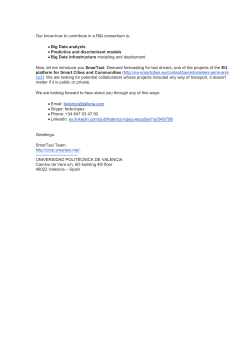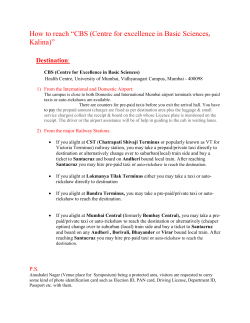
SAMPLE PROFIT & LOSS STATEMENT
SAMPLE PROFIT & LOSS STATEMENT OF TAXI BUSINESS ( TAXI'S DRIVEN BY OWNER) NOTES Each component of financial statement is to be valued at VEP amount. 1. 2. 3. 4. 5. 6. 7. 8. 9. 10. 11. 12. 13. 14. 15. 16. 17. 18. 19. 20. 21. Taxi Fare – Total of taxi fare earned during financial year. Tips Received from Passengers –Amount tips received by passengers in a financial year. Total operating income – Total of taxi fare earned plus tips received from passengers. Proceeds from Fixed Assets – Value of consideration received from sale of fixed assets during a year. Total Non Operating Income – Add all non operating income. Total Income – Total operating income plus total non operating income. Fuel & Oil – Total cost of fuel & oil used in taxi during a year for purpose of producing the income. Repairs & Maintenance – Cost incurred in repairing the taxis used in business. Base Fee – Base fee paid and incurred during the year. Fees paid to LTA – Total fees paid to LTA during the year such as passing fees, wheel tax etc excluding fines. Depreciation Taxi – depreciation charged on total cost of taxis owned by the business. Figure to be brought from fixed assets and depreciation schedule for taxis used in a business. Total Operating Expenses – Add all the operating expenses. Bank Charges – Total bank charges incurred in having of the business bank account for taxis. Interest – Total interest expenses incurred on overdraft and loan account related to taxi business. Total Financial Expenses - Add all the financial expenses. Written down value of the taxi sold – Written down value of the taxis at the date which it is sold. (Cost of the taxi minus accumulated depreciation till the selling date of the taxi.) Total other expenses – Add all other expenses. Total Expenses – Total operating expenses plus total financial expenses plus total other expenses. Expenses on Private Use of Taxi – Refer to section 14(2) of Fringe Benefit Decree 2012 to determine the value per quarter according to Taxi’s engine capacity. Multiply value per quarter by 4 to get the actual value for expenses on private use of taxi for a financial year. Total Expenses for Taxi Business – Total Expenses minus expenses on private use of taxi. Net profit before tax – Total Income minus total expenses for taxi business. SAMPLE PROFIT & LOSS STATEMENT OF TAXI BUSINESS (CONTRACTED TO DRIVER) NOTES Each component of financial statement is to be valued at VEP amount. 1. Taxi Income – Total taxi income received from drivers during the financial year. 2. Proceeds from Fixed Assets – Value of consideration received from sale of fixed assets during a year. 3. Total Non Operating Income – Add all non operating income. 4. Total Income – Total operating income plus total non operating income. 5. Repairs & Maintenance – Cost incurred in repairing the taxi used in business. 6. Base Fee – Base fee paid and incurred during the year. 7. Fees paid to LTA – Total fees paid to LTA during the year such as passing fees etc excluding fines. 8. Depreciation Taxi – depreciation charged on total cost of taxis owned by the business. Figure to be brought from fixed assets and depreciation schedule for taxis used in a business. 9. Total Operating Expenses – Add all the operating expenses. 10. Bank Charges – Total bank charges incurred in having of the business bank account for taxis. 11. Interest – Total interest expenses incurred on overdraft and loan account related to taxi business. 12. Total Financial Expenses - Add all the financial expenses. 13. Written down value of the taxi sold – Written down value of the taxis at the date which it is sold. (Cost of the taxi minus accumulated depreciation till the selling date of the taxi.) 14. Total other expenses – Add all other expenses. 15. Total Expenses – Total operating expenses plus total financial expenses plus total other expenses. 16. Expenses on Private Use of Taxi – Refer to section 14(2) of Fringe Benefit Decree 2012 to determine the value per quarter according to Taxi’s engine capacity. Multiply value per quarter by 4 to get the actual value for expenses on private use of taxi for a financial year. 17. Total Expenses for Taxi Business – Total Expenses minus expenses on private use of taxi. 18. Net profit before tax – Total Income minus total expenses for taxi business. SAMPLE BALANCE SHEET OF TAXI BUSINESS NOTES Each component of financial statement is to be valued at VEP amount. 1. Cash at Bank - This closing bank balance of a year from the bank reconciliation or bank statement which is ending balance as at 31st December. 2. Cash on Hands - Ending balance, as at 31 December of cash held on hand. 3. Debtors – Amount of money owed to your business by individual or organisation as at end of current financial year. 4. Insurance in advance – Amount of insurance expenses paid in advance for taxi insurance before it has been incurred. 5. Total Current Assets - Add all current assets. 6. Taxi –Value of all taxis owned by business valued at historical cost. 7. Accumulated Depreciation - Total depreciation on taxis from date of acquisition till year end date. 8. Cost of taxis less accumulated depreciation on taxis (Written down Value). 9. Land – Historical cost of land owned by you or your business. 10. Building – Value of building owned by you for personal use. 11. Accumulated Depreciation - Total depreciation on building from date of acquisition till year end date. 12. Value of building less accumulated depreciation on building (Written down Value). 13. Motor Vehicle – Value of all motor vehicles owned you for personal use valued at purchase price. 14. Accumulated Depreciation - Total depreciation on motor vehicle from date of acquisition till year end date. 15. Purchase price of motor vehicle less accumulated depreciation on motor vehicle (Written down Value). 16. Total Fixed Assets – Total of written down value of all assets plus value of land. 17. Total Assets – Current assets plus fixed assets. 18. Creditors – Total amount of money owed by you or your business to individuals (including friends and relatives) and organization which can be paid within 12 months period. 19. Total Current Liabilities - Total amount of all current liabilities. 20. Loan payable – Amount of loan is to be paid as at end of the year either payable to financial institution or any other party (including friends and relatives). 21. Taxi loan payable – Amount of loan to be paid for taxi as at end of the year either payable to financial institution or any other party (including friends and relatives). 22. Total Long Term Liabilities – Add all long term liabilities. 23. Total Liabilities – Total current liabilities plus total long term liabilities. 24. Net Assets – Total assets minus total liabilities. 25. Beginning Capital – Amount of capital at the start of this financial year (closing capital of last financial year). 26. Net Profit after income tax – Net profit of the current year after income tax has been subjected to it. 27. Beginning capital plus net profit after income tax. 28. Drawings – Total value of cash taken by owner from the business for personal use during the year. 29. Closing Equity – Beginning capital plus net profit after income tax minus drawings.
© Copyright 2025










